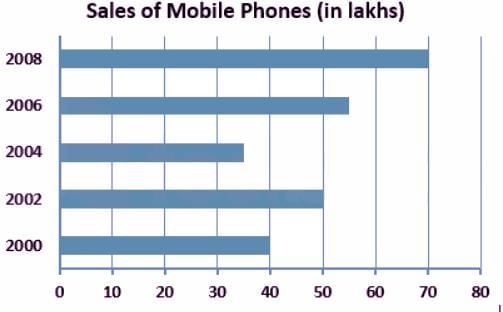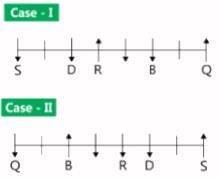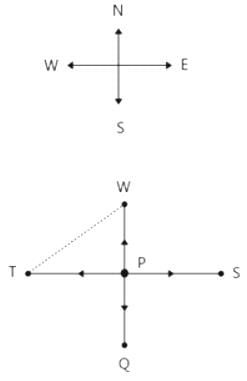CISF Head Constable Mock Test - 5 - CDS MCQ
30 Questions MCQ Test - CISF Head Constable Mock Test - 5
Group Question
Answer the following question based on the information given below.
A major telecom company recently hired a new Chief Financial Officer to take command of the company’s finances. This move came against the backdrop of national and global economic crises.
The CFO is charged with the responsibility of realigning the finances of the largest Strategic Business Unit which deals with network solutions to major corporate clients in the country. In wake of the overall financial slump, many of the corporate clients have been delaying the payment of their recurring dues for the monthly network and internet services utilised. The local account managers handling those clients and their respective Regional Managers had been given the authority to maintain client relations and if necessary allow the delayed payments with a view to continue a long-term relationship with the key clients. However, the new CFO after taking stock of the situation decided to put an affirmative end to this practice. He sent a mail to every regional and local account manager asking them to discontinue services to the defaulting clients. In spite of such a strong communication, most major clients delayed the payments in the next month. As a response to this, the CFO resent his earlier mail asking for comments. In the next month, the single largest client defaulted on the payment and the regional manager promptly asked the technology company to terminate services to that client. The regional manger merely informed the client that the delay in payment was responsible for the termination of services and the service would be reconstituted on payment of the dues.
The client faced severe difficulties due to discontinuation of the internet and local network services. The CEO of that company wrote a scathing email to the Chairman of the telecom company.
The CEO pointed out the sudden, mishandled and improperly communicated decision and its severe impact on his company’s business. He pointed out that they were one of the largest clients of the telecom company. The CEO also hinted that his company would want to reconsider their future engagement. The Chairman decided to maintain the relations with that important client and yet protect his company’s image. He promptly restarted the network services and yet requested the client to clear the dues within a week and to avoid major delays especially in these times of crisis. The client replied to this communication, agreeing to the specified norms. However, the Chairman decided to severely reprimand the Regional Manager and suspended him for 2 weeks. He also severely questioned the CFO for his error. At the next board of directors meeting, there was support for the Chairman’s action in spite of protests by some senior directors who defended the CFO and the Regional Manager's actions.
Q. Which of the following could be a probable reason for the Chairman to reprimand the CFO?
A major telecom company recently hired a new Chief Financial Officer to take command of the company’s finances. This move came against the backdrop of national and global economic crises.
The CFO is charged with the responsibility of realigning the finances of the largest Strategic Business Unit which deals with network solutions to major corporate clients in the country. In wake of the overall financial slump, many of the corporate clients have been delaying the payment of their recurring dues for the monthly network and internet services utilised. The local account managers handling those clients and their respective Regional Managers had been given the authority to maintain client relations and if necessary allow the delayed payments with a view to continue a long-term relationship with the key clients. However, the new CFO after taking stock of the situation decided to put an affirmative end to this practice. He sent a mail to every regional and local account manager asking them to discontinue services to the defaulting clients. In spite of such a strong communication, most major clients delayed the payments in the next month. As a response to this, the CFO resent his earlier mail asking for comments. In the next month, the single largest client defaulted on the payment and the regional manager promptly asked the technology company to terminate services to that client. The regional manger merely informed the client that the delay in payment was responsible for the termination of services and the service would be reconstituted on payment of the dues.
The client faced severe difficulties due to discontinuation of the internet and local network services. The CEO of that company wrote a scathing email to the Chairman of the telecom company.
The CEO pointed out the sudden, mishandled and improperly communicated decision and its severe impact on his company’s business. He pointed out that they were one of the largest clients of the telecom company. The CEO also hinted that his company would want to reconsider their future engagement. The Chairman decided to maintain the relations with that important client and yet protect his company’s image. He promptly restarted the network services and yet requested the client to clear the dues within a week and to avoid major delays especially in these times of crisis. The client replied to this communication, agreeing to the specified norms. However, the Chairman decided to severely reprimand the Regional Manager and suspended him for 2 weeks. He also severely questioned the CFO for his error. At the next board of directors meeting, there was support for the Chairman’s action in spite of protests by some senior directors who defended the CFO and the Regional Manager's actions.
Directions to Solve
In each of the following questions find out the alternative which will replace the question mark.
Question -
BEGK : ADFJ :: PSVY : ?
Directions: Study the following information carefully and answer the questions given beside:
Eight persons- A, B, C, D, P, Q, R and S are sitting in a row in which some of them are facing north while some of them are facing south. Only 3 persons sit to the left of R. 3 persons sit between R and Q. B is 2nd to the left of Q. More than 2 people’s sits between B and S, D is 2nd to the left of S. Neighbours of R are facing south. Neighbours of P face the same direction. C is 2nd to the right of A. A and P face opposite directions and similarly B and Q face opposite directions too.
Q. Who among the following is third to the right of B?
Direction : Study the following question carefully and choose the right answer.
Q: If in a code language ‘PUTREFY’ is written as ‘XPQSTRL’ and ‘NAVIGATE’ is written as ‘GYMOWYQT’ how is ‘AVIARY’ written in that language?
Directions: Study the following information carefully and answer the questions given below:
P is to the North of Q and S is to the east of P, who is to the south of W. T is to the west of P.
Q. W is in which direction with respect to T?
Study the following line graph and answer the questins.
Exports from Three Companies Over the Years (in Rs. crore)

Q. Average annual exports during the given period for Company Y is approximately what percent of the average annual exports for Company Z?
What is the difference between the simple interest on a principal of Rs. 500 being calculated at 5% per annum for 3 years and 4% per annum for 4 years?
Raju is twice as good as Vijay. Together, they finish the work in 14 days. In how many days can Vijay alone do the same work?
Based on the bar graph given, calculate the approximate percentage increase in sales of mobile phones from 2004 to 2008.

Find out the Synonym of the following word:
PROPEL
Find out the Synonym of the following word:
FORAY
He will certainly help you / if you will ask him / in a pleasant / No error.
The first problem to be tackled was that of feeding the huge population of the country after Independence. It became (1)____ to adopt (2)____for agricultural development. The (3)____ of multipurpose (4)____with the development of (5)____ as one of its (6)____ components was the (7)____ step towards the provision of (8)____ infrastructure. It was realised that (9)____ is the basic (10)____ in developing agriculture. The total irrigation potential was, therefore, increased.
Q. Find the word most appropriate for Blank no. 9
The first problem to be tackled was that of feeding the huge population of the country after Independence. It became (1)____ to adopt (2)____for agricultural development. The (3)____ of multipurpose (4)____with the development of (5)____ as one of its (6)____ components was the (7)____ step towards the provision of (8)____ infrastructure. It was realised that (9)____ is the basic (10)____ in developing agriculture. The total irrigation potential was, therefore, increased.
Q. Find the word most appropriate for Blank no. 10
Statisticians from the Department of Motor Vehicles have calculated that one human being should be struck every three minutes by a vehicle, while each minutetwo animals can be expected to die from such collisions.
Direction: The sentences given in the question, when properly sequenced, form a coherent paragraph. Each sentence is labeled with a letter. Choose the most logical order of sentences from the given choices to construct a coherent paragraph.
A. In 17th-century Amsterdam, it was highly common for the guilds to commission portraits of themselves wearing their uniforms and holding weapons.
B. It was Rembrandt’s riveting interplay of light, motion, texture and expression transformed a commonplace commission into a masterwork.
C. Its status and critical acclaim, though, have little to do with its subject matter: a civic-guard group tasked with keeping watch on the city walls.
D. The painting Militia Company of District II Under the Command of Captain Frans Banninck Cocq, better-known as The Night Watch, is probably Rembrandt’s most famous work.
Direction: Read the following passage carefully and answer the following questions.
The Bureau of Indian Standards (BIS) has kicked off the process to set new standards to measure quality of services offered to consumers across different sectors, including telecom, aviation, e-commerce and healthcare.
The BIS, which sets the quality regulations for various products from gold to bottled water, on Friday called a meeting of industry bodies to “persuade them to be part of the process and give their inputs.”
“Service sector is one of the key sectors of the Indian economy with a huge potential to grow into one of the largest markets of the world. Standards can play a major facilitative role in this regard. It is important that the standardisation needs and priorities of the sector are determined,” a senior official said.
During the meeting, the BIS pointed out that the initial focus will be the 12 champion services sectors identified by the government. These include IT, tourism and hospitality, transport and logistics, accounting and finance services, legal services, communication services and construction.
The Bureau of Indian Standards (BIS) standards is set to formulate a framework for quality services that should be provided to consumers and also talk about the benchmarks to deal with consumer complaints or after sales service in an effort to ensure quality in the services sector.
At a meeting with industry bodies on Friday, it has been decided that the BIS will set up a separate ‘divisional council’ for services in a month’s time. Under this, different technical committees will be set up — one for each service. The committees will have various stakeholders such as government officials, experts and industry representatives.
The process was initiated after concerns over lack of standardisation, particularly with regards to after-sales service, in their feedback to the Ministry of Consumer Affairs.
In a poll, online community network LocalCircles found that in the absence of defined customer service standards in the country, a majority of consumers were not happy with after-sales services. As per the poll, 43% feel that mobile handset and computer manufacturers are the worst in after-sales services, followed by white goods firms (38%) and automobile companies (11%). About 93% of respondents said brands should at least acknowledge complaints from users within 72 hours. “Many consumers complained that customer service numbers of many companies do not work,” according to LocalCircles.
Q. Which among the following is true regarding the poll conducted by the community network LocalCircles regarding customer service in India?
I. The mobile phone manufacturers are mostly interested in selling the products without giving much attention to the after sales service
II. Many sectors in India are facing the issue of after sales service in the country and nothing is being done to take care of this issue
III. It is important that the complaints of the customers should be acknowledged first by the service providers
The mountains which are not a part of the Himalayan chain:
In which year, Ashok Mehta Committee was appointed to review the working of Panchayati Raj institution?
The first grammarian of the Sanskrit language was -
Which ministry signed an MoU with the Indian Plumbing Association for water use efficiency?
Which organization received the GeM award in the "Timely Payments (CPSEs)" category?





























